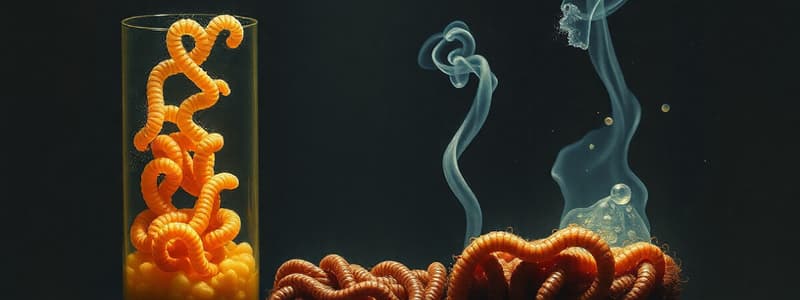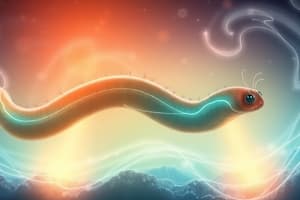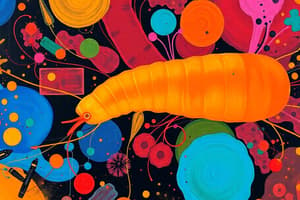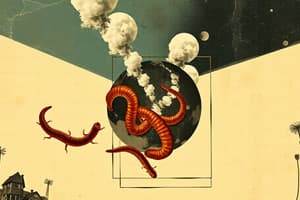Podcast
Questions and Answers
What is the primary aim of the practical involving the mealworms?
What is the primary aim of the practical involving the mealworms?
- To determine the impact of temperature on mealworm behavior.
- To measure the growth rate of mealworms over time.
- To assess the effect of different environments on mealworm survival.
- To observe the change in oxygen content in a boiling tube. (correct)
What is the purpose of using soda lime in this experiment?
What is the purpose of using soda lime in this experiment?
- To provide nutrients for the mealworms.
- To absorb oxygen from the boiling tube.
- To act as a heat conductor during the experiment.
- To absorb carbon dioxide released by the mealworms. (correct)
What does the movement of the color marker in tube A indicate?
What does the movement of the color marker in tube A indicate?
- A rise in carbon dioxide levels in the environment.
- A change in the temperature of the mealworms.
- A decrease in oxygen concentration in the tube. (correct)
- An increase in oxygen concentration in the tube.
What safety precautions should be taken when conducting this experiment?
What safety precautions should be taken when conducting this experiment?
Which component is responsible for measuring the oxygen level in the apparatus?
Which component is responsible for measuring the oxygen level in the apparatus?
What should be done after setting up the apparatus?
What should be done after setting up the apparatus?
What type of tube is used to conduct this experiment?
What type of tube is used to conduct this experiment?
What is the function of the ruler in the experiment?
What is the function of the ruler in the experiment?
What is the main precaution to take when handling mealworms?
What is the main precaution to take when handling mealworms?
What should you do after stopping the tubes?
What should you do after stopping the tubes?
How long should the set-up be left before recording results?
How long should the set-up be left before recording results?
In the experiment, if the indicator in tube A changes color, what does it imply about the gas exchange of the mealworms?
In the experiment, if the indicator in tube A changes color, what does it imply about the gas exchange of the mealworms?
What phenomenon does tube B represent in the gas exchange experiment?
What phenomenon does tube B represent in the gas exchange experiment?
What is the significance of ensuring there are no air leaks in the tubes?
What is the significance of ensuring there are no air leaks in the tubes?
If the indicator in tube B remains unchanged while that in tube A changes color, what does this suggest about the carbon dioxide levels?
If the indicator in tube B remains unchanged while that in tube A changes color, what does this suggest about the carbon dioxide levels?
What could be a reason for the difference in carbon dioxide content between the two tubes?
What could be a reason for the difference in carbon dioxide content between the two tubes?
What is the primary function of the air sacs in the lungs?
What is the primary function of the air sacs in the lungs?
What surrounds the surfaces of the air sacs to aid in gas exchange?
What surrounds the surfaces of the air sacs to aid in gas exchange?
How does air travel into the air sacs of the lungs?
How does air travel into the air sacs of the lungs?
Which muscle plays a significant role in enabling breathing by changing the volume of the thoracic cavity?
Which muscle plays a significant role in enabling breathing by changing the volume of the thoracic cavity?
Which structure is primarily involved in conducting air from the trachea to the lungs?
Which structure is primarily involved in conducting air from the trachea to the lungs?
Which of the following is NOT a component of the breathing system?
Which of the following is NOT a component of the breathing system?
What is the main purpose of the intercostal muscles during respiration?
What is the main purpose of the intercostal muscles during respiration?
What role do the nostrils play in the breathing mechanism?
What role do the nostrils play in the breathing mechanism?
What is the primary purpose of using the drinking straw in the gas jar experiment?
What is the primary purpose of using the drinking straw in the gas jar experiment?
What safety precaution is mentioned for the experiment involving the drinking straw?
What safety precaution is mentioned for the experiment involving the drinking straw?
When filling the gas jar, what air type is initially present?
When filling the gas jar, what air type is initially present?
What should be done to prevent water from splashing out of the gas jar during the experiment?
What should be done to prevent water from splashing out of the gas jar during the experiment?
What happens to the gas jar after repeatedly blowing into the drinking straw?
What happens to the gas jar after repeatedly blowing into the drinking straw?
How is the air in the gas jar labeled after the inhaled air is present?
How is the air in the gas jar labeled after the inhaled air is present?
Why is it necessary for the gas jar to be completely filled with water in the setup?
Why is it necessary for the gas jar to be completely filled with water in the setup?
What is the expected gas composition after completing the exhalation process into the gas jar?
What is the expected gas composition after completing the exhalation process into the gas jar?
What happens to lung tissue when it is squeezed in water?
What happens to lung tissue when it is squeezed in water?
What role do capillaries play in the gas exchange process in the lungs?
What role do capillaries play in the gas exchange process in the lungs?
During inhalation, what occurs in the air sacs of the lungs?
During inhalation, what occurs in the air sacs of the lungs?
What effect does carbon monoxide have on the blood in smokers?
What effect does carbon monoxide have on the blood in smokers?
What is the main product of respiration that the body cells produce?
What is the main product of respiration that the body cells produce?
What happens to the air sacs in a smoker's lungs due to emphysema?
What happens to the air sacs in a smoker's lungs due to emphysema?
What action removes carbon dioxide from the body?
What action removes carbon dioxide from the body?
What characterizes chronic bronchitis compared to normal bronchioles?
What characterizes chronic bronchitis compared to normal bronchioles?
How does blood contribute to the gas exchange process?
How does blood contribute to the gas exchange process?
What is a direct consequence of the loss of surface area in the air sacs of smokers?
What is a direct consequence of the loss of surface area in the air sacs of smokers?
Which of the following statements is true regarding the impact of smoking on lung tissue?
Which of the following statements is true regarding the impact of smoking on lung tissue?
What occurs when we breathe out?
What occurs when we breathe out?
How does inflammation contribute to chronic bronchitis?
How does inflammation contribute to chronic bronchitis?
What is a common respiratory disease associated with smoking that affects the air sacs?
What is a common respiratory disease associated with smoking that affects the air sacs?
What primary change occurs in bronchioles as a result of chronic bronchitis?
What primary change occurs in bronchioles as a result of chronic bronchitis?
Flashcards
Purpose of tube B
Purpose of tube B
Tube B acts as a control group to compare the effects of mealworms on the indicator in tube A.
Mealworm gas exchange
Mealworm gas exchange
Mealworms consume oxygen and produce carbon dioxide during respiration.
Indicator color change
Indicator color change
The color change of the indicator solution indicates the presence of carbon dioxide.
Control tube purpose
Control tube purpose
Signup and view all the flashcards
Carbon dioxide production
Carbon dioxide production
Signup and view all the flashcards
Gas exchange in mealworms
Gas exchange in mealworms
Signup and view all the flashcards
Experiment setup
Experiment setup
Signup and view all the flashcards
Importance of preventing air leakage
Importance of preventing air leakage
Signup and view all the flashcards
Soda Lime's Role
Soda Lime's Role
Signup and view all the flashcards
Variable in Tube A
Variable in Tube A
Signup and view all the flashcards
Measurement Method
Measurement Method
Signup and view all the flashcards
Color Marker Movement (Tube A)
Color Marker Movement (Tube A)
Signup and view all the flashcards
Safety Precautions
Safety Precautions
Signup and view all the flashcards
Experiment Duration
Experiment Duration
Signup and view all the flashcards
Inhaled air
Inhaled air
Signup and view all the flashcards
Exhaled air
Exhaled air
Signup and view all the flashcards
Gas jar
Gas jar
Signup and view all the flashcards
Water trough
Water trough
Signup and view all the flashcards
Drinking straw
Drinking straw
Signup and view all the flashcards
Fill a gas jar
Fill a gas jar
Signup and view all the flashcards
Caution: Exhaled air
Caution: Exhaled air
Signup and view all the flashcards
Blow slowly avoid splashing
Blow slowly avoid splashing
Signup and view all the flashcards
Air Sacs
Air Sacs
Signup and view all the flashcards
Capillaries
Capillaries
Signup and view all the flashcards
Gas Exchange
Gas Exchange
Signup and view all the flashcards
Trachea
Trachea
Signup and view all the flashcards
Bronchi
Bronchi
Signup and view all the flashcards
Bronchioles
Bronchioles
Signup and view all the flashcards
Nasal Cavity
Nasal Cavity
Signup and view all the flashcards
Diaphragm
Diaphragm
Signup and view all the flashcards
Lung Tissue Feature
Lung Tissue Feature
Signup and view all the flashcards
What happens when you breathe in?
What happens when you breathe in?
Signup and view all the flashcards
Oxygen Transport
Oxygen Transport
Signup and view all the flashcards
Carbon Dioxide Transport
Carbon Dioxide Transport
Signup and view all the flashcards
Exhaling Carbon Dioxide
Exhaling Carbon Dioxide
Signup and view all the flashcards
Gas Exchange and Respiration
Gas Exchange and Respiration
Signup and view all the flashcards
Smoker's Lung Tissue
Smoker's Lung Tissue
Signup and view all the flashcards
Carbon Monoxide's Effect
Carbon Monoxide's Effect
Signup and view all the flashcards
Damaged Air Sacs
Damaged Air Sacs
Signup and view all the flashcards
Emphysema
Emphysema
Signup and view all the flashcards
Chronic Bronchitis
Chronic Bronchitis
Signup and view all the flashcards
Bronchiole Narrowing
Bronchiole Narrowing
Signup and view all the flashcards
Gas Exchange Efficiency
Gas Exchange Efficiency
Signup and view all the flashcards
Respiratory Diseases from Smoking
Respiratory Diseases from Smoking
Signup and view all the flashcards
Study Notes
Gas Exchange in Animals
- Gas exchange occurs in both plants and animals.
- Practical 7.12 examines carbon dioxide uptake/release in mealworms.
- Materials needed include: boiling tubes, forceps, cotton thread, stoppers, a test tube rack, a measuring cylinder (10 cm³), hydrogencarbonate indicator, and mealworms in a plastic vial with small holes.
- Add 3 cm³ of hydrogencarbonate indicator to two boiling tubes (A and B).
- Put some mealworms into a plastic vial with small holes and place it inside boiling tube A.
- Ensure mealworms don't touch the indicator.
- Seal both tubes to prevent air leakage.
- Observe and record the indicator color change after one hour.
Practical 7.13 - Study of Oxygen Uptake/Release in Animals
- The goal is to study the change in oxygen content in a boiling tube with mealworms.
- The experiment setup involves: Boiling tubes, capillary tubes fitted with stoppers and a color marker inside, wire gauze, a ruler, soda lime, and mealworms
- Capillary tubes are fitted into stoppers for observing oxygen uptake/release.
- Leave the setup for 20 minutes, and measure the distance between the color marker and the stopper.
Studying Gas Exchange in Humans
- Humans have a specialized breathing system for gas exchange.
- Gas exchange ensures the body receives oxygen for respiration and eliminates carbon dioxide waste.
- Breathing and respiration are distinct processes.
- Breathing involves moving air into and out of the lungs.
- Respiration is a chemical process releasing energy from food in cells.
Comparing Inhaled and Exhaled Air
- The composition and temperature of inhaled and exhaled air differ.
- Practical 7.14 compares the oxygen, carbon dioxide, and water vapor content.
- The procedure involves: Gas jars with cover plates, measuring cylinder, mirrors, dry cobalt chloride paper, stopwatch
- This experiment measured how long a candle takes to extinguish within a jar of inhaled air and a jar containing exhaled air.
Gas Exchange at the Air Sacs
- Oxygen and carbon dioxide are exchanged between the air in the air sacs and the blood in the capillaries.
- Oxygen in inhaled air enters the capillaries in the air sacs.
- The blood carries oxygen to the body cells.
- The blood carries carbon dioxide to the air sacs.
- Carbon dioxide moves into the air sacs and is expelled during exhaling.
Effects of Smoking on Gas Exchange
- Smoking reduces the efficiency of gas exchange.
- Tar deposits in the lungs, reducing the surface area for gas exchange.
- Carbon monoxide reduces blood's oxygen-carrying capacity.
- Chemicals damage the air sacs.
- This worsens conditions like emphysema and chronic bronchitis.
Further Information
- Different animals use various structures for gas exchange (e.g., gills in fish, skin and lungs in amphibians).
- The large surface area in the lungs enhances the efficiency of gas exchange.
Studying That Suits You
Use AI to generate personalized quizzes and flashcards to suit your learning preferences.
Related Documents
Description
This quiz covers critical aspects of the practical experiment involving mealworms and gas exchange. Questions focus on the purpose of materials used, safety precautions, and interpretation of results. Test your understanding of the experimental setup and the physical concepts behind the observations.




